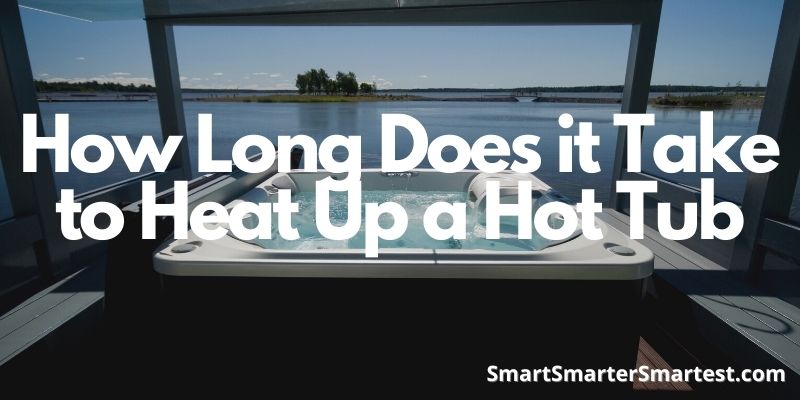People often ask how long it takes to heat up a hot tub. The answer to this question isn’t so straightforward since heating up a tub depends on a number of factors. Factors such as outdoor temperature, the capacity of the heating element and even the tub cover can all affect the speed at which a tub can heat up.
The succeeding paragraphs discuss different scenarios which help you understand wuss may happen under different circumstances in order to help you temper expectations.

In Short
Heating a tub can take anywhere between 3 to 8 hours, although four hours would be considered the average heating time. However, there are many things to consider in order to determine just how long a tub can actually heat up.
The size of the tub, the temperature of the surroundings where the tub is placed as well as the temperature of the water coming from the tap all affect the rate at which the water heats up.
How Quickly Will It Heat Up?
Generally, a hot tub in good working condition will raise the water temperature between 3-6 degrees per hour. Leaving the cover on prevents heat from escaping thus making the water heat up faster.
Air temperature is another factor that can affect heating if the hot tub is located outdoors. Simply put, warmer temperatures makes heating easier and faster. On a warm, sunny day heating up the water to 100 degrees will take approximately four hours.
The condition of the hot tub’s parts also affect the rate at which the tub heats up. The water heater, the pump, the jets and even the cover may affect how the tub heats up. Expect heating to take longer if the parts are old and worn out
Does a Hot Tub Heat Faster with Jets On?
The answer is yes.
Jets are a fantastic addition to any spa. Jets provide a gentle massaging effect on the user, making him or her feel more relaxed.
Aside from providing added comfort to the user however, added jets aid in heating. These jets speed up heating in tubs, thus saving the owner a lot of time and electricity as well! Switching the jets on makes the water circulate which, in turn, helps in an even distribution of heat. Without the jets, pockets of cold water usually get left in the pipes.
The jets help expel these pockets of cold water into the tub so they get heated up along with the water in the tub. Using this process, water heats up at around three to six degrees per hour. One thing to remember about this process though is to make sure that the tub is already filled with water before the jets are switched on.
Some owners think that running the jets on a half-filled tub hastens heating. However, running jets when they are not yet submerged in water may cause damage to the jets.
In the absence of jets, an alternative would be to swirl the water using your hands or a pool noodle. This, of course, isn’t as efficient as jets but this method can still help in water circulation and still shorten heating time.
Another point to remember is the importance of the lid. A lid will always aid in speeding up the heating process. Therefore, it will help to keep the tub covered whenever possible.
Size of the hot tub
For obvious reasons, it will take longer to heat up a tub with a 700L capacity as compared to one with a 300L capacity. In the same manner, it would definitely take longer to heat up a 700L tub using a 1 kilowatt heater. It would be wise then to consider a tub size that is just right for you.
Consider the impracticality of having a 5 to 6 -seater tub meant for only one to two persons. This would mean a big waste not only in the amount of water used, but also in the time it would take to heat up all that water! This would mean a lot of wasted energy, not to mention the impact it will have on the environment.
It would be good to always consider the compatibility of the tub’s capacity to the heater being recommended that is supposed to come with the tub. A low budget tub might come with a heater of low wattage and quality as compared to a high-end model which will come with a more powerful heater. This should be assessed and taken into much consideration.
Final Words: Heating efficiency
As was mentioned previously, hot tubs rarely need to be heated up as they are usually left on permanently. Although heat loss is to be expected, current designs and technological advancements in terms of manufacturing have made these tubs moll efficient in terms of temperature control and maintenance.
This means less work for your tub’s heater and lessened costs. This also means less waiting time for you is you want to take that dip at the soonest time possible.
Added features that contribute to heat maintenance are the cabinets in which these tubs are enclosed. These are made from high-quality materials which are meant to provide good insulation.
Highly efficient covers which trap heat are also available.
Cheap tubs may initially seem to be more economical. However, they turn out to be more expensive in the long run to operate since they usually are not as thermally efficient. This means the heating element will have to work more resulting in higher operational costs for you, the owner.